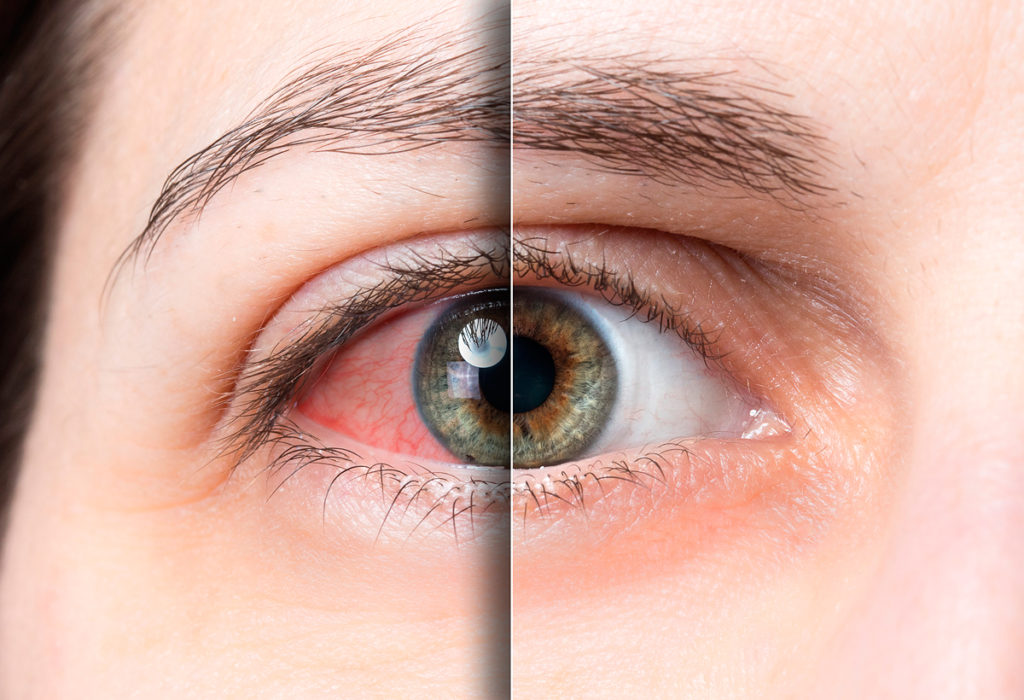Сontents
- Interferons in clinical practice
- Interferon-α2b in conjunctival papillomatosis
- Interferon α2b in neoplasia of the eye surface
- Interferons α2a and α2b in ophthalmic disorders of the eye surface
- Interferons-alpha for the metastases of renal cell cancer
- Interferon α2a and α2b in the treatment of uveitis
- Serpiginous choroidopathy therapy with interferon-α2a
- Interferons α2a and α2b in macular disorders
- Interferon side effects in the treatment of ophthalmic diseases
- Conclusions
- Source
Interferons in clinical practice
Interferons are a group of signaling proteins that are found only invertebrates. The biological functions of interferons are diverse: antiviral, immunomodulatory, and antiproliferative. Stimulation of cell membrane receptors by interferons causes activation of several hundred genes. Interferons are divided into 3 main types depending on their biological functions and interaction with specific receptors.
Type I interferons regulate the innate and acquired immune response. They activate cells in the immune system to suppress infections and fight cancer cells. Regulation is carried out through interaction with the membrane receptor IFNAR.
Among all type I interferons, there is a group of alpha interferons, for which a recombinant form has been developed. It is obtained by genetic engineering, so it is impossible to get blood-borne infections through it. Recombinant forms of interferon-alpha-2a (IFN-α2a) and alpha-2b (IFN-α2b) are used in clinical therapy for the treatment of cancer, hematological disorders, hepatitis B and C, and viral skin diseases. IFN-α2a and IFN-α2b are also used in ophthalmology to treat the anterior and posterior segments of the eyeball.
Interferon-α2b in conjunctival papillomatosis
Interferon α2b has properties to suppress human papillomavirus (HPV). In cases of recurrent HPV-induced lesions, IFN-α2b is used in systemic and local adjuvant therapy. IFN-α2b reduces the viral load in the conjunctival epithelial cells that produce the mucin layer of the tear film.
When treating conjunctival papillomatosis with recombinant IFN-α2b, a subconjunctival injection is made with surgical excision and cryotherapy.
Conjunctival papillomas are treated with a local application of IFN-α2b at a dosage of 1 million IU/ml 4 times a day. Complete resolution of the disease occurs without relapse within 6 weeks with no side effects.
Papillomas of the lacrimal SAC and tubules are a rare cause of epiphora, which is also treated with a local application of IFN-α2b.
In cases of recurrent squamous cell papilloma, IFN-α2b is applied topically as eye drops and intravenously under the conjunctiva. Long-term treatment for 8 months leads to remission without relapse. In this case, IFN-α2b demonstrates an antiangiogenic effect that reduces the growth of fibroblasts.
Interferon α2b in neoplasia of the eye surface
Ocular surface squamous neoplasia (OSSN) is the most common ocular surface tumor and manifests as an abnormal growth of squamous epithelial cells on the eye’s surface. OSSN can be either benign or malignant. The tumor can affect the conjunctiva and the cornea’s surface and sometimes penetrate the eyeball, orbit, and nasolacrimal system.
Risk factors for OSSN include exposure to solar UV-B radiation, cigarette smoke, human papillomavirus, human immunodeficiency virus, petroleum products, immunosuppressant medication after organ transplantation, and corneal transplantation.
Squamous cell neoplasia is treated with surgery or chemotherapy. In the past, the primary treatment for OSSN was surgical excision of the tumor. However, the probability of recurrence after surgery reached 56%.
OSSN is treated with topical drugs, including mitomycin C, fluorouracil, and interferon-alpha-2b. The advantage of these drugs over the surgical treatment of OSSN is that they cover the entire surface of the eye, so they act not only on the affected area but also on distant parts of the eye, in which OSSN may develop asymptomatically. The drugs are administered topically as monotherapy or as an adjunct to surgical excision if the recurrence risk increases.
Most physicians treat OSSN with mitomycin C or interferon-alpha-2b. Mitomycin C can cause side effects such as eye pain, tearing, irritation, and limbal stem cell deficiency.
Compared to mitomycin C, interferon-alpha-2b is safer and causes fewer side effects:
- A study in rabbits showed that topical IFN-alpha-2b was not toxic to the eyes.
- Studies in patients with OSSN have shown that treatment with interferon-alpha-2b at 1 million IU/mL rarely causes side effects. However, all side effects were resolved independently. Among the side effects of interferon are ocular discomfort and photophobia in 10% of patients, conjunctival hyperemia in 12%, follicular conjunctivitis in 7-20%, irritation in 10%, and superficial keratitis in 1 reported case.
The mode of action of interferon is based on the involvement of phagocytes of the innate immune system in the tumor tissue. NK cells (natural killer cells) and T lymphocytes destroy tumor cells, leading to regression of squamous cell neoplasia.
Clinical studies have shown the effectiveness of interferon-alpha-2b for the treatment of OSSN:
- Local IFN-alpha-2b is effective in monotherapy for ocular surface squamous cell neoplasia in a dosage of 1 million IU/ml 4 times daily. Side effects may appear after 3 weeks in the form of intratumoral bleeding.
- Other studies have used higher doses of IFN-alpha-2b to eliminate the tumor. In one case, the recommended dose was 3 million IU/ml 4 times a day, with therapy repeated 3 months after clinical resolution of the tumor. In another study, an explanation of conjunctival and corneal intraepithelial lesions was achieved within 6 weeks. In the first stage, a single subconjunctival injection of recombinant interferon-alpha-2b at a dosage of 3 million IU/ml was used. In the second stage, drops of IFN-alpha-2b were prescribed for topical application at a concentration of 1 million IU/ml 4 times a day.
- In one study, there was an initial increase in the volume of the conjunctival-corneal intraepithelial tumor at the beginning of IFN-alpha-2b therapy. However, cancer completely regressed within 60 days.
- In an Indian clinical study, patients with OSSN were given 1 million IU/mL IFN-alpha-2b eye drops 4 times daily until complete clinical resolution of the tumor. In 91.6% of patients, the tumors entirely resolved within 3.25 months. There were no long-term complications or relapses. The article “Interferon-Alpha-2b to Treat Ocular Surface Tumors” contains details of the study. The study was published in the Asia-Pacific Journal of Ophthalmology.
- American scientists investigated the effectiveness of interferon-alpha-2b in the treatment of patients with OSSN. The study involved 20 people. Patients received only topical interferon without subconjunctival injections. IFN-alpha-2b eye drops at 1 million IU/ml dosage were administered 4 times daily. In this study, patients had tumors of different stages: Tis, a precancerous condition in which the tumor has not spread to adjacent tissues, and T3, a more profoundly penetrating malignancy. After topical treatment with interferon-alpha-2b, the tumor entirely resolved in 83% of cases, on average, within 6 months. In 17% of cases, the cancer resolved partially. Details of the study are placed in the article “Interferon-Alpha-2b Is Effective and Safe to Treat Ocular Surface Squamous Neoplasia“. The study is published in the JAMA Ophthalmology
- In an Indian clinical study, 31 patients with OSSN were given IFN-alpha-2b eye drops at 1 million IU/mL 4 times daily. At the same time, interferon was not stored in the refrigerator. The tumor is entirely resolved in 83.9% of cases. The average time for complete resolution of the cancer is 12 weeks. The article “Interferon-Alpha-2b to Treat Ocular Surface Tumors” contains details of the study. The study was published in the Indian Journal of Ophthalmology.
Topical interferon-alpha-2b is effective and safe for treating squamous cell neoplasia of the ocular surface, not only a precancerous Tis condition but also stage T3, a more profoundly penetrating malignancy. Interferon treatment should only be initiated after histopathological confirmation of OSSN.
Interferons α2a and α2b in ophthalmic disorders of the eye surface
Primary acquired melanosis with atypia is successfully treated with topical IFN-α2b without any systemic or local side effects. Treatment is carried out in 6-week courses with short intervals between them and a dosage of 1 million IU/ml 5 times a day. After the first course, the tumor decreases by 66%, after the second – by 55%, after the third – by 74% of the 2nd. In a clinical study, it was recorded that one patient needed 6 courses to get a 98% reduction in the tumor compared to the original size.
IFN-α2b topical eye drops are also used for additional therapy of patients with conjunctival melanoma after surgery.
The most common lymphoma of the appendages of the eye is B-cell lymphoma. It is most often diagnosed in elderly patients. For its treatment, IFN-α2b is injected into the lesion subconjunctivally at a dosage of 1.5 million IU for 4 weeks, 3 times a week. With positive dynamics, the treatment cycle is repeated in a dosage of 1 million IU with the same frequency and duration of therapy. As a result of this approach, there is a complete resolution of the disease with a small number of short-term side effects. At the same time, relapse is observed in 15% of cases.
Bilateral Moray ulcers in patients with chronic hepatitis are also successfully treated with topical IFN-α2b. Monotherapy with interferon-α2b at a dosage of 1 million IU / ml (1 drop every 2 hours) eliminating the lesion without causing a relapse.
In the treatment of spring keratoconjunctivitis, topical IFN-α2b is active at a dosage of 1 million IU/ml 4 times a day for 2 months.
Local therapy of herpes simplex keratitis is traditionally performed with acyclovir. However, for strains resistant to acyclovir, it is practical to use IFN-α2a additionally. For patients with weakened immunity, this additional therapy is also recommended. The therapeutic effect is based on the immunomodulatory action of IFN-α2a to attract cytotoxic T-lymphocytes, NK cells, and macrophages to the affected corneal fragments.
Several studies have found that ophthalmologists can use IFN-α2b in the pre-and postoperative period. In glaucoma surgery, IFN-α2b is used to reduce the number of corneal complications. The effect is based on inhibiting the proliferation of Tenon capsule fibroblasts. And after excimer laser photorefractive keratectomy, interferon prevents corneal opacification. But it can cause a delay in epithelial healing since it induces an inflammatory immune response.
Interferons-alpha for the metastases of renal cell cancer
Interferon-alpha has a direct antiproliferative effect on kidney cancer cells in vitro. It stimulates the body’s mononuclear cells and increases the expression of genes of the main histocompatibility complex.
As monotherapy for intraocular metastases of renal cell carcinoma, the effect of IFN-α is estimated to be approximately 20%. Therefore, its use in combination with 13-CIS-retinoic acid or with interleukin-2 and fluorouracil together is recommended for treatment.
One study described the successful use of IFN-α for conservative treatment of iris metastasis. The tumor completely regressed within 16 weeks after the start of treatment. A reduction in its size began after 3 weeks.
Interferon α2a and α2b in the treatment of uveitis
Immunosuppressants are widely used to treat vision-threatening severe uveitis. If uveitis is resistant to traditional therapy, IFN-α2a and IFN-α2b drugs can be used as an alternative treatment.
A study of 12 patients treated with uveitis demonstrated a positive clinical response in 83%. The opacity of the vitreous body decreased, and macular edema disappeared during the first days of therapy. Patients were given IFN-α2b subcutaneously at a dosage of 3 million IU per day for 3 days. Then for a period of 2 to 4 weeks, the dose was increased to 6 million IU per day. Then, depending on the dynamics of the disease, the dose was individually adjusted. Side effects were well tolerated by patients, although they were frequent.
In another study (45 patients), the clinical result was achieved in 82.6% of cases with Behcet’s disease. In patients with other types of uveitis – in 59% of cases. IFN-α2a was administered subcutaneously at a dosage of 3 million IU 3 times a week.
However, there is no consensus among doctors on the dosage of IFN-α2a in the treatment of uveitis. In some studies, maximum concentrations reach 6 to 9 million IU per injection, while in other studies, doses below 3 million IU are administered for safety reasons.
Serpiginous choroidopathy therapy with interferon-α2a
serpiginous choroidopathy – chronic progressive loss of the pigment of the retina and choriocapillaris. The disease is accompanied by relapses and leads to loss of vision. Daily subconjunctival injections of 1 million IU IFN-α2a help maintain visual acuity, stop the progression of the disease, and cause remission. The therapeutic effect is based on increasing the expression of class I HLA antigen in lymphoid cells and redirecting the activity of T-lymphocytes.
Therapy with interferon can be used as an alternative method for the treatment of refractory forms of serpiginous choroidopathy. IFN-α2a is also a good substitute for immunosuppressive drugs in the development of significant side effects.
Side effects of treatment are manifested in the form of myalgia and transient fever, which means that the drug enters the bloodstream. However, subconjunctival administration is not sufficient as a systemic dose. However, the potential toxicity of IFN-α2a with subconjunctival administration is subject to further investigation.
Interferons α2a and α2b in macular disorders
A large number of studies have noted the effectiveness of interferon-alpha therapy in patients with cystic macular edema (CME).
Interferon α2a is included in the treatment regimen for post-infectious uveitis with CME. When administered in low doses, IFN-α2a can maintain remission for a long time. Traditional anti-inflammatory therapy for chronic CME in the absence of results can be replaced with the use of IFN-α2a.
During 6 months of interferon-α2a therapy, patients ‘ visual acuity improved, inflammatory symptoms regressed, vascular leakage decreased, and the average Central macular thickness increased. However, the antiexudative mechanisms of action of interferon drugs remain unclear.
Many studies have shown the effectiveness of IFN-α2a and IFN-α2b for the treatment of refractory CME secondary uveitis. Researchers administered IFN-α2a subcutaneously at doses of 3 or 6 million IU per day (depending on body weight). The dose of IFN-α2b was 6 million IU per day. The therapy was carried out for 6 months. The administered dose of the drug was decreasing every month.
Interferon side effects in the treatment of ophthalmic diseases
Minimal side effects are observed when using local IFN-α2b eye drops. Patients well tolerate the drug. Possible side effects: follicular conjunctivitis, superficial keratopathy.
Side effects of subcutaneous IFN-α2a administration were also well tolerated by patients. The most common flu symptoms are redness and pain at the injection site, nausea, and loss of appetite.
Some studies report severe side effects when IFN-α2a and IFN-α2b are administered in high doses: vomiting, diarrhea, abdominal pain, sweating, itching, hair loss, hypertension, hypotension, arrhythmia, myocardial Infarction, depression, psoriasis exacerbation, and thyroid dysfunction.
Many side effects were reversible when the doses of interferon injections were reduced.
Conclusions
Researchers have demonstrated the potential of treating ophthalmic diseases with interferons-alpha. The effectiveness of the eye anterior and posterior segments treatment has been proven. IFN-α2a and IFN-α2b were useful as alternative treatments in cases where conventional therapy did not lead to significant improvement.
Medications for topical use in the form of eye drops were the safest and caused fewer side effects.
Retrobulbar injections were more effective than systemic treatment.
References
- Interferon Alpha 2a and 2b in Ophthalmology: A Review
- Topical Interferon Alfa-2b for Management of Ocular Surface Squamous Neoplasia in 23 Cases
- Ocular surface squamous neoplasia: a survey of changes in the standard of care from 2003 to 2012
- Topical Interferon α-2b as a Single Therapy for Primary Ocular Surface Squamous Neoplasia
- Study of efficacy and safety of reconstituted, recombinant human interferon alpha 2b eyedrops without refrigeration as a therapy for immunoreduction and/or treatment of ocular surface squamous neoplasia



